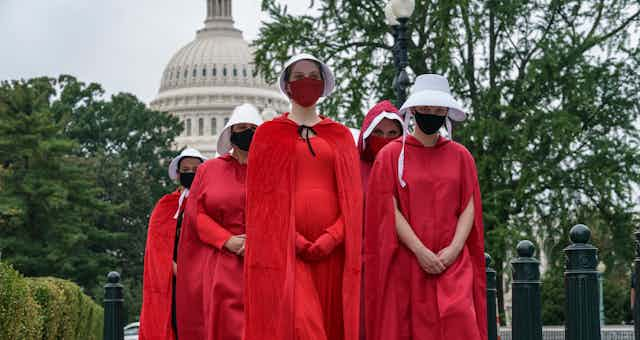Recent debates around Roe v. Wade in the United States have sparked new conversations about the right to abortion and what it means.

On the one hand, the anti-abortion movement envisions a fetus as an individual with rights.
On the other hand, pro-choice advocates believe individuals with uteruses should have control over their own reproduction and futures.
Before and after abortion was decriminalized in Canada in 1969, writers have explored how abortion taps into networks of meaning and our cultural imagination about women’s bodies and the future. In fiction and literary scholarship, abortion draws on the complicated history of gender, sexuality and women’s rights.
Figuratively, to abort is to expel or to miscarry. To abort becomes entangled with our perceptions of how we shape the future.
‘No Clouds of Glory’ / ‘Sarah Bastard’s Notebook’
Although many of her works explore motherhood, Canadian novelist Marian Engel’s first novel No Clouds of Glory (1968), later re-titled Sarah Bastard’s Notebook (1974), pivots on an abortion.
In retrospect, the protagonist Sarah names her first unborn fetus Antonio. Sarah’s abortion is complicated by social pressure to keep an affair with her sister’s husband a secret. Choosing to name the fetus encapsulates her search for love and identity. She imagines herself as an “almost-mother” to a strong and loving boy with whom she can share the world. Antonio becomes an antidote for her loneliness.
But Sarah’s desire to be a writer marks her as an unusual woman, a monstrosity. The aborted fetus also personifies the fear she has of finding value in the world as an author rather than a mother. As literary scholar Cinda Gault suggests, Sarah is someone who imagines the domestic sphere as being prison-like and incarcerating women based on “assumptions about sexuality and reproduction.”
Sarah’s multiple abortions are literally related to her unease with gendered expectations. They also figuratively represent her self-sabotage as a writer. Only when she comes to understand her identity, seeking another abortion to sustain her independence, can she overcome her abortive tendencies as a writer.
Reproductive futures
Abortions get caught up in morality, in sexuality and in what literary critic and queer theorist Lee Edelman calls “reproductive futurism” — dominant society’s cis-gendered heteronormative investment in the figure of the innocent child. The fetus, he argues, is seen as the future and the potential for what heteronormative narratives desire society to be. As historian Jennifer Holland argues, anti-abortion advocates have “made fetal life feel personal to many Americans.”
Lee’s discussion demonstrates the complexity and charged nature of abortion as a cultural metaphor. He asks, when a particular fetus is seen as embodying our collective future: “Who would, after all, come out for abortion or stand against reproduction, against futurity, and so against life?”
In asking this question, Lee scrutinizes how “the queer,” seen as aligned with pro-choice advocacy, is positioned to embody “a relentlessly narcissistic, antisocial and future-negating drive.”
Abortion comes to stand in for monstrosity. Cells that have the ability to express as nerve, bone and organ tissue (read: brain and heart) get imaginatively conceived as a squirming, breathing baby, the hope for our future and survival.
‘The Handmaid’s Tale’
In The Handmaid’s Tale (1985), novelist Margaret Atwood’s future dystopian American state, Gilead, demonstrates how cultural anxieties about female infertility become entwined in the politics of abortion.

The novel’s postscript links abortion to birth control and “plummeting Caucasian birth rates.” Gilead, it would seem, restricts women’s independence in a highly structured white supremacist, theocratic and totalitarian society. Here, Atwood connects abortion as a reproductive technology to histories of racist and religious oppression.
But critics of the novel note that its avoidance of directly addressing race ultimately erases the voices and struggles of Black and racialized women, as writer Melayna Williams argues. Writer Noah Berlatsky notes that while “America has always been a dystopia for people of colour,” this acknowledgement is missing from Atwood’s novel.
Read more: Hulu's 'The Handmaid's Tale' casts Canada as a racial utopia
Abortion riots
The omission of racist histories of oppression and violence against Black and racialized women, including oppressive histories of sexual and reproductive control, stands out considering how reproductive rights feature in the novel.
The character Janine confesses to being traumatically “gang-raped at fourteen.” She testifies to having had an abortion, while the narrator, June, remembers her pro-choice mother coming back from “the abortion riots” bruised and bleeding.
Although not seeking an abortion, June still wants her right to choose not to be raped and to choose when, how and with whom she shares her reproductive abilities as they impact her future. In Atwood’s novel, Gilead terminates the freedom of individuals with viable uteruses — it “aborts” women’s futures.
Engel, Atwood and other writers aren’t simply interested in whether abortion is right or wrong. They want to know how abortion gets entwined with love, hate, despair and joy, with sexuality and desire, with abuse, violence and histories of colonialism and patriarchy.
They examine how abortion becomes a part of the analogies and metaphors through which we imagine the future. And, as women, they want to know whether they’ll have a choice in how their own futures unfold.

